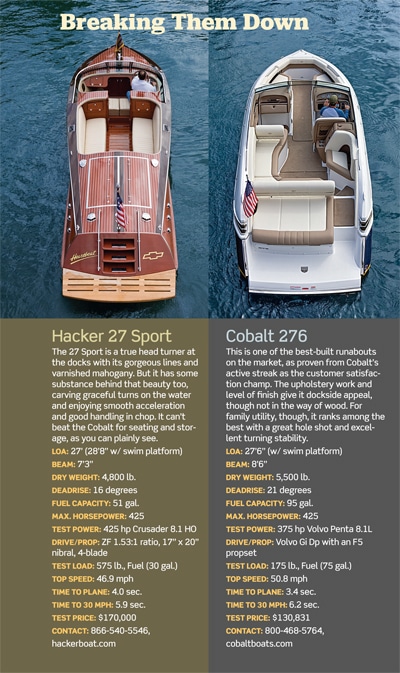There is nothing more picturesque in the eyes of a boater than the site of a classic Chris-Craft, Gar Wood or Hacker-Craft glistening in the sun as it runs along the shore of a treelined lake, or, in this case, as it sat still at a dock reflecting the minimal light penetrating a hard bank of clouds. Literally staring down at the glossy, narrow-beamed 27-foot Hacker under my nose, I was filled with an appreciation for craftsmanship from a time passed, an era lost with the onset of easier-to-build-and-maintain fiberglass hulls. And then I had to remind myself: This boat of old at my feet was not a classic. It wasn’t even old. It was as new as the Cobalt 276 sitting 10 feet away. Both boats were alluring. Both among the elite. But as I would discover, they couldn’t have been more different, inside and out.
What is it about mahogany boats? If we’re so attracted to them, why did their day in the sun so long ago set? The answer: work. They took time to build and even more time to maintain, which is why you see so many old wooden boats sitting in various stages of neglect in sheds around the country. For nearly 50 years the overwhelming majority of production powerboats has been constructed of fiberglass.
It’s gotten to the point where the mere sight of wood on a boat entices the question: “What year is it?”
This Hacker 27 Sport? Model-year 2010.
Next question: “How does it stack up against today’s elite fiberglass model?”
I had gone to the Adirondack region of New York to find out for myself.
How We Got Here
First we have to understand that we owe our modern boating legacy to the great wooden boatbuilders of a century ago. Hacker-Craft’s founder, John Ludwig Hacker, built his first production boat in Michigan, a 32-foot-6-inch boat powered by a 55 hp Speedway engine that hit 23 mph. In 1911 he built the first boat to top 50 mph in the United States. Hacker is also credited with building the first “runabout” style boat, when he moved the engine midship and set the helm controls in the cockpit forward of the engine box.
Following John Hacker’s death in 1961, the company went through ownership changes, a period of virtual darkness and finally a move east to one of the hot spots of the wooden boat subculture: forest-ringed Lake George, New York.
Most boaters believe wood-runabout building disappeared for good a few decades ago, with the exception of those created by weekend woodsmiths. While it’s true that they’ll never again be true production boats because they take so long to build, wood runabouts are still alive. In a barn sitting a few hundred feet off the shore of Lake George’s Silver Bay, I took in the smell of fresh sawdust and the sounds of woodworking tools. Upstairs, two boats sat in different stages of construction. Craftsmen would be working with the mahogany for eight to 10 weeks. Next, in the finish shop, it would be another eight to 10 weeks to install the engine and hardware and finish off the decks. The topside would eventually take 12 to 16 coats of hand-brushed varnish, sanded between every application. All told, it would take four to six months to deliver one of these boats.
“It’s very labor intensive,” said Lynn Wagemann, the current owner of Hacker Boats. “We’re selling the labor and craftsmanship, not the raw-material costs.”
About 1,000 board feet of mahogany planks went into building the 27 Sport, named Heartbeat, that sat against the dock next to the Cobalt, waiting to be tested. The hull bottom is actually a hybrid of wood and epoxy, which makes the boat completely watertight and prevents the wood from expanding and contracting as is so common with antique boats. Its tri-directional bottom is comprised of two layers of crisscrossed, one-quarter-inch-thick mahogany planks and an outer layer of longitudinally laid planks. This technique means that, on the ownership end, the boat will no longer be what we’ve come to expect from wood: a time-intensive labor of love, or just a royal pain in the ass. The materials, as I was about to find out, also make a big difference in the on-water comparison with fiberglass.
Acid Test: Hacker vs. Cobalt
For fairness’ sake, this was not a total apples-to-apples comparison. The Hacker was powered by a 425 hp Crusader inboard, the Cobalt 276 a 375 hp Volvo Penta stern-drive. Centers of gravity and drag coefficients are markedly different as a result. The Hacker is long and lean, with a low profile to the water. It resembles a classic sports car. The Cobalt has higher freeboard, an open bow and an open cockpit. It takes after a high-end sport ute. I was mindful of this as I made my way out to the water.
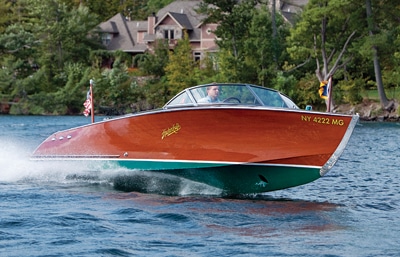
After a slow idle to soak in the back-in-time feel of the Hacker, I accelerated out onto Lake George. The boat had almost no bowrise out of the hole. The transition from idle to plane was as smooth as silk. There was none of the jolt that you get when throwing down the throttle on some 25- to 30-foot fiberglass stern-drive boats.
I noticed the different sound of the water reflecting off wood too. It’s quieter. Builders have made much advancement in fiberglass quality over the years, but the fact remains that wood has superior sound-deadening properties. When the Hacker crossed through a wake, I never detected the thud that I’ve come to expect with glass hulls. That 1-inch-thick tri-directional hull bottom was in full effect.
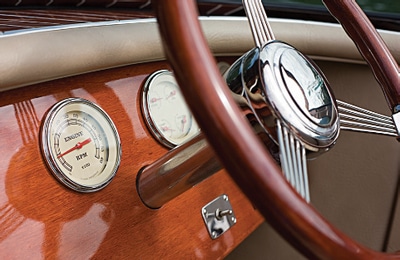
The Hacker took my hardest turns at cruise speeds smoothly. It felt like a German sports car hugging the road. With that in mind, I decided to try the same hard turn at full throttle. It gave back the same smooth response — and instantly became one of the most fun boats to handle that I’ve ever driven.
The Cobalt was more familiar to me. Sitting in the bucket helm seat with the flip-up bolster put me in a driving position to which I’ve grown accustomed. As far as modern fiberglass production goes, Cobalt dials it in. While it’s not working with handcrafted mahogany planks, Cobalt takes the extra step by washing its molds after every hull is popped, which is more labor intensive yet makes for fewer flaws or dimples in the gelcoat. Cobalt reinforces its hulls’ chines and keel with Kevlar, the stuff used in bulletproof vests. It bonds its stringer grid to the hull with Plexus adhesive, and the hull is chemically bonded and bolted through to the deck. The deck is cored with honeycomb rather than plywood for a better strength-to-weight ratio. All of this would factor into the test results.
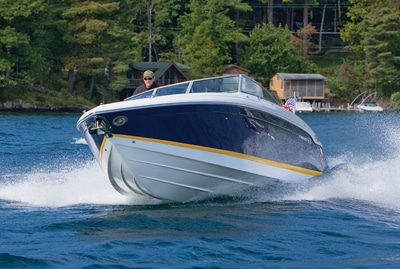
I throttled up the Cobalt and it hopped on plane quicker than most fiberglass runabouts of its size. In fact, despite an extra 700 pounds (due to its beamier and heavier fiberglass build), the Cobalt beat the Hacker out of the hole by a full second. It also topped 50 mph with less horsepower. But, being a sterndrive with a true deep-V hull (a 21-degree deadrise at the transom, compared with 16 degrees for the Hacker), it experienced a little inevitable squat and bowrise out of the hole. Not much compared with countless other glass boats I’ve tested, but noticeable after driving the Hacker.
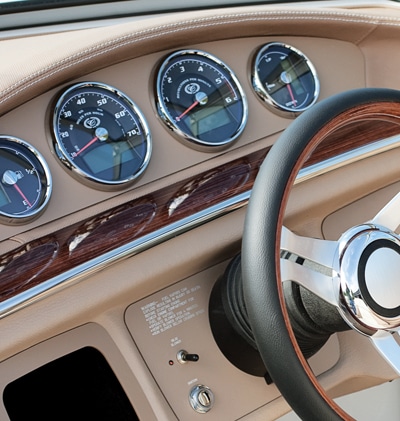
Running through waves and chop, the Cobalt had more of a big-boat feel. It’s different from the Hacker. You’re more protected from spray and wind, but there’s a little less flair in the handling. One thing I also noticed was no rattling. Even the Bimini didn’t rattle. Still, I swung back to the dock to remove the Bimini for a better performance comparison and discovered another noticeable difference.
Around the docks, the Cobalt’s Volvo stern-drive with counter-rotating Duoprops made it an easy boat to dock. I slid it into its spot among the classic Hackers with no sweat. Using just the inboard, I noticed the Hacker was not as forgiving, making worries about dinging that fine mahogany jump into my head. I performed my usual bow tuck and reverse that always slides a stern-drive or outboard into place on the dock. But the inboard prop forward of the rudder allowed only for adjustments to port, and my commands went unheeded. Wagemann stepped in before crunch time and showed off the Hacker’s ace in the hole: a bow thruster.
“A lot of guys get a thruster because an inboard is difficult to handle if you’re not used to it,” he said. This takes another maintenance aspect of classics out of the equation: repairing nicks to the varnish and wood due to dock encounters. With the thruster, the Hacker obeyed around the dock even better than the Cobalt.
Final Word
You’d think, with its labor-intensive handcrafted hull and add-ons such as a thruster, the Hacker would cost three times the Cobalt. Not so. Our test Hacker cost only $40,000 more than the Cobalt I tested ($170,000 compared with $130,831). A lot of money to be sure, but at least the boats are hanging in the same neighborhood. While Cobalt is meticulous in its builds, the cost differential can be attributed to the handcrafting of wood versus using a fiberglass mold. You’re paying for labor.
So what’s the final verdict? It’s hard for any fiberglass boat to beat that classic look and feel of a varnished mahogany boat. But it’s hard for a wooden boat to be the multisport vehicle a modern fiberglass model can be. Wood has come a long way, baby, but it’s still going to require more maintenance than fiberglass. So, do you pine for the glossy look, contained cockpit and scent of varnished new mahogany, or do you gravitate toward an open entertainment cockpit and the reflective and shiny look of gelcoat? If you want classic sports car, wood is good. For an aquatic sport ute, glass is the way to go.
